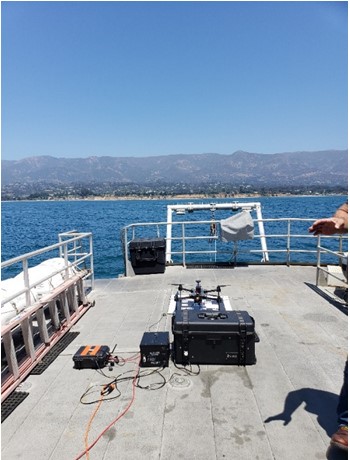Forecast for Harmful Algal Blooms in Lake Erie 2019
The UAS Program Office is supporting Dr. Stumpf, (NOAA/National Centers for Coastal Ocean Science (NCCOS), on a project where the goal is to use sUAS (small Unmanned Aircraft Systems) to deploy harmful algal bloom (HAB) sensors and to develop and demonstrate a rapid, cost-effective response capability in order to more quickly and accurately know the location of bloom patches. Advancing this real-time detection capability would enable states (especially Florida) and counties to more effectively deploy and focus their limited sampling resources. Furthermore, this capability would enhance NOAA’s HAB forecasting capability so as to be able to provide improved warnings to the public, and therein increase public safety and reduce economic impact. This capability, once demonstrated, will be transitioned to states for integration into their HAB monitoring programs. Improved HAB forecasting is identified as an agency priority in the NOAA Next Generation Strategic Plan Objective – Improved coastal water quality supporting human health and coastal ecosystem services and as a Line Office mission goal in NOS Priorities Roadmap, under “Threats to human health and safety from ecological hazards”.
On July 11, 2019 Dr. Richard Stumpf attended a Harmful Algal Bloom (HAB) Workshop (“Forecast for Harmful Algal Blooms in Lake Erie 2019”) hosted by Ohio Sea Grant & Stone Lab. At the workshop, he presented the seasonal forecast for the HAB in western Lake Erie, developed by NOAA and its research partners. Western Lake Erie will experience a significant harmful algal bloom (HAB) this summer, expected to measure 7.5 on the severity index, but could range between 6 and 9. An index above 5 indicates blooms having greater impact. The severity index is based on bloom's biomass – the amount of algae – over a sustained period. The largest blooms occurred in 2011, with a severity index of 10, and 2015, at 10.5. Last year’s bloom had a severity index of 3.6, while 2017's was 8.0.
Lake Erie blooms consist of cyanobacteria, also called blue-green algae that are capable of producing the liver toxin microcystin that poses a risk to human and wildlife health. Such blooms may result in higher costs for cities and local governments that need to treat drinking water, prevent people from enjoying fishing, swimming, boating and visiting the shoreline, and harm the region’s vital summer tourism economy. These effects will vary in location and severity due to winds that may concentrate or dissipate the bloom.
“Communities along Lake Erie rely upon clean, healthy water to support their community’s well-being and economic livelihoods,” said Nicole LeBoeuf, acting director of NOAA’s National Ocean Service. “This forecast provides timely and trusted science-based information to water managers and public health officials so they can better anticipate blooms, mitigate impacts and reduce future outbreaks.”
This year, the lake temperature has remained relatively cool due to the higher-than-average rainfall in the region, so the bloom is not expected to start until late July when the water temperature reaches 65 to 70 degrees F. This contrasts with 2018, when exceptionally warm weather at the beginning of June caused an early start. Calm winds in July, especially in western Lake Erie, tend to allow the algal toxins t
Forecast for Harmful Algal Blooms in Lake Erie 2019 Read More »


